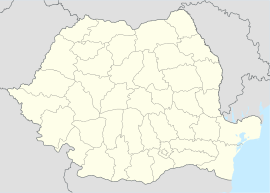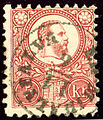world.wikisort.org - Romania
Valea lui Mihai (Romanian pronunciation: [ˈvale̯a luj miˈhaj]; Hungarian: Érmihályfalva) is a town in Bihor County, Crișana, Romania.
Valea lui Mihai
Érmihályfalva | |
|---|---|
Town | |
 | |
 Coat of arms | |
 Location in Bihor County | |
 Valea lui Mihai Location in Romania | |
| Coordinates: 47°31′12″N 22°7′48″E | |
| Country | Romania |
| County | Bihor |
| Government | |
| • Mayor (2020–2024) | József Nyakó[1] (UDMR) |
| Area | 73.54 km2 (28.39 sq mi) |
| Population (2011)[2] | 9,902 |
| • Density | 130/km2 (350/sq mi) |
| Time zone | EET/EEST (UTC+2/+3) |
| Vehicle reg. | BH |
| Website | www |
Geography
It is located around 66 km north-east of Oradea, 9 km from the Hungarian border in Bihor County, Crișana, Romania.
History
In 1312, under Charles I, it was allowed new trade privileges and then in 1459 was also allowed tax benefits privileges for its citizens. Later it was part of the Ottoman Empire, which resulted in its depopulation, but the inhabitants subsequently returned. Thereafter, it was part of the Habsburg monarchy up until the Austro-Hungarian Compromise of 1867. Then it became part of the Kingdom of Hungary within Austria-Hungary.
After the breaking-up of Austria-Hungary in 1918/1920, the town became part of Romania. As a result of the Second Vienna Award it became a part of Hungary between 1940 and 1945. Since then it has been part of Romania. It was declared a town on three separate occasions: in 1844, 1930 and 1989, the last time as a result of the Romanian rural systematization program.
Jewish history
Jews from Galicia settled around 1780, engaging in agriculture and commerce. A junior high school was opened in 1873. Anschel Bak opened a printing press in the late 19th century. Fifty Hungarian Hasidic rabbis held a convention in the town in 1898.[3]
In 1930, there were 1535 Jews, or 19% of the total. During the interwar period, Jews were the leaders of local industry, employing hundreds of workers. Some Zionist youth groups were founded in the 1930s. In 1935, the town was the site of the HaNoar HaTzioni national convention.[3]
The Jewish population was sent to the Oradea ghetto in May 1944 and subsequently deported to Auschwitz. Some of the survivors returned briefly to the town after the war.[3]
Population
| Year | Pop. | ±% |
|---|---|---|
| 1930 | 8,085 | — |
| 1992 | 10,505 | +29.9% |
| 2002 | 10,665 | +1.5% |
| 2011 | 9,688 | −9.2% |
| Source: Census data | ||
According to the last census from 2011 there were 9,668 people living within the city.
Of this population, 81.03% are ethnic Hungarians, while 13.23% are ethnic Romanians and 1.3% others.[4]
Image gallery
- The Roman Catholic church of the town
- Street in Valea lui Mihai
- Er-Mihalyfalva on Hungary stamp issued in 1871
References
- "Results of the 2020 local elections". Central Electoral Bureau. Retrieved 9 June 2021.
- "Populaţia stabilă pe judeţe, municipii, oraşe şi localităti componenete la RPL_2011" (XLS). National Institute of Statistics.
- Shmuel Spector, Geoffrey Wigoder (eds.), The Encyclopedia of Jewish Life Before and During the Holocaust: Seredna-Budna—Z, p. 1372-73. New York University Press, 2001, ISBN 0-8147-9378-9
- Romanian 2002 Census
External links
| Wikimedia Commons has media related to Valea lui Mihai. |
На других языках
- [en] Valea lui Mihai
[ru] Валя-луй-Михай
Валя-луй-Михай (рум. Valea lui Mihai, венг. Érmihályfalva) — город в Румынии в составе жудеца Бихор.Другой контент может иметь иную лицензию. Перед использованием материалов сайта WikiSort.org внимательно изучите правила лицензирования конкретных элементов наполнения сайта.
WikiSort.org - проект по пересортировке и дополнению контента Википедии



